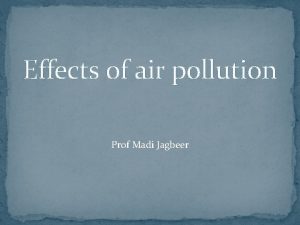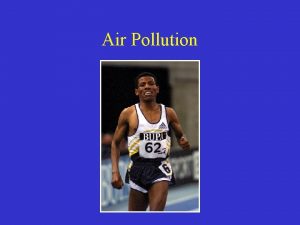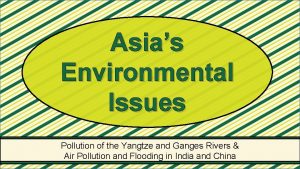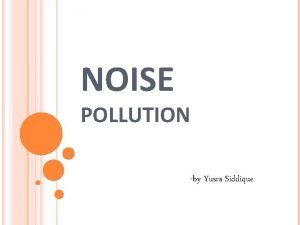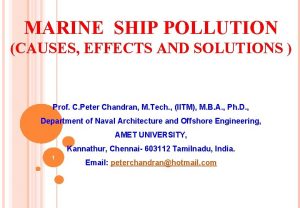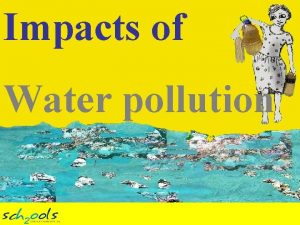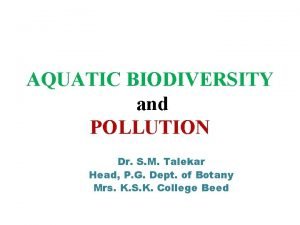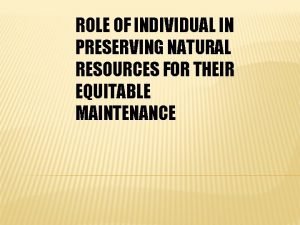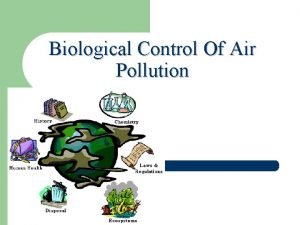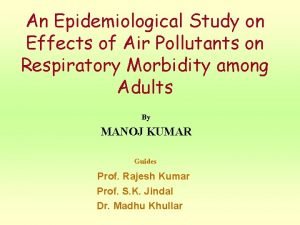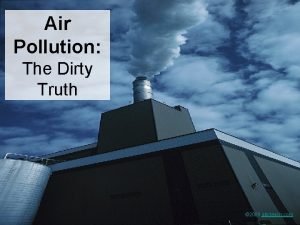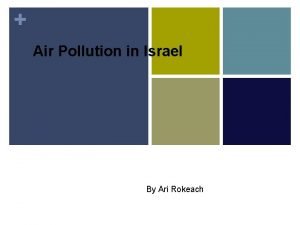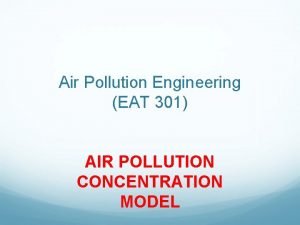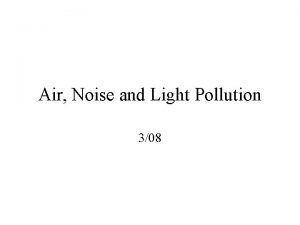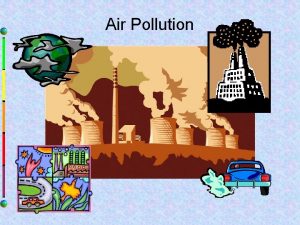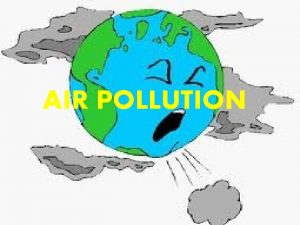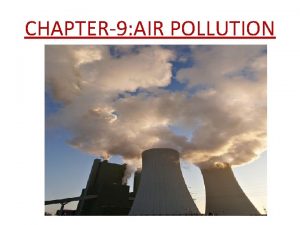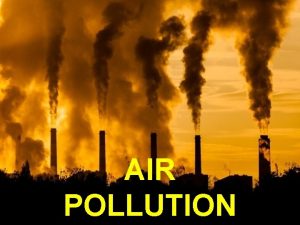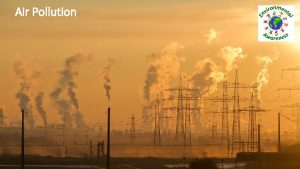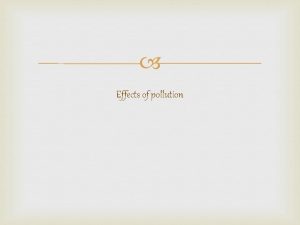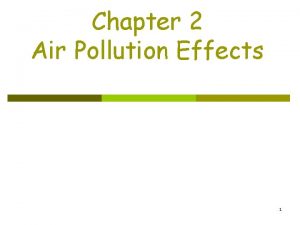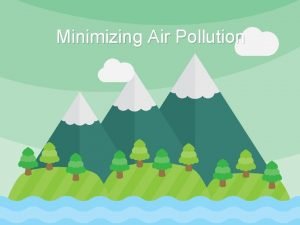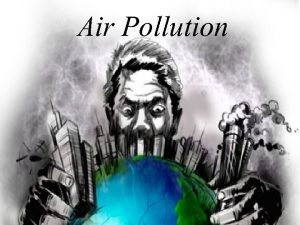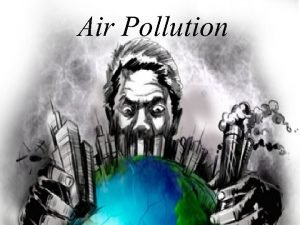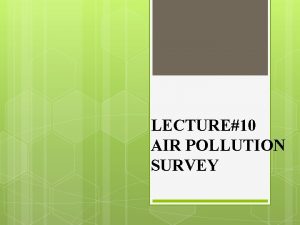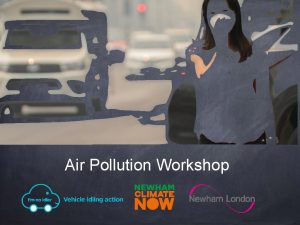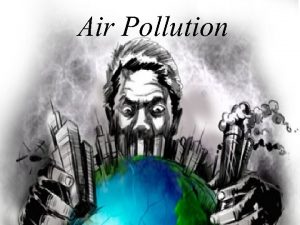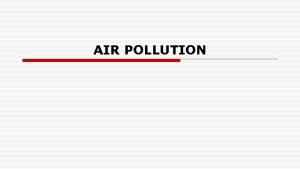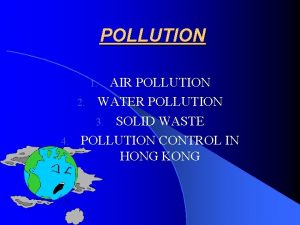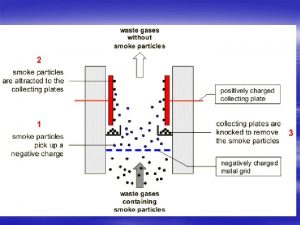Air Pollution Air Pollution Has many effects on


























- Slides: 26

Air Pollution

Air Pollution: • Has many effects on public health and the environment. • Comes in different forms and from many sources. • Ozone and Particulate matter are two types of Air Pollution that affect Kansas.


What is AQI? • https: //www. youtube. com/watch? v=tn. R 7 by. HOOLA

The Air Quality Index (AQI) Values 0 to 50 51 to 100 101 to 150 Levels of Health Concern Good Moderate Unhealthy for Sensitive Groups 151 to 200 Unhealthy 201 to 300 Very Unhealthy 301 to 500 Hazardous

What Makes a Bad Ozone Day in Kansas?

Smog Alert Service • Notifies you by e‑mail or fax when ozone levels are predicted to be unhealthy in your area. • Is available in most areas in New England. • Is a free service. • To receive Smog Alerts, register at (www. epa. gov/region 01/oms) Smog Alert Notification Areas Interior CT Or contact Maine DEP’s Ozone Hotline at 1 -800 -223 -1196 or www. state. me. us/dep/air/ozone. htm Coastal CT Rhode Island Southeastern MA Central & Northeastern MA Western MA Southern NH Coastal ME

Primary Air Pollutants • Carbon Monoxide CO vehicles from gas burning • Nitrogen Oxides Nox and cars • Sulfur Dioxide S 02 fuels from power plants from burning fossil • Volatile Organic Compounds VOC burning fuels, vehicles are major source • Particulate Matter PM from construction, agriculture, forest, fires from

Man Made Sources of NOx

Go Outdoors with CO 2 Monitors

• https: //www. youtube. com/watch? v=UJx. QFJ 5 c. Eo g • https: //www. youtube. com/watch? v=o. YVIAP 2 rdaw

What is Ozone? • An odorless, colorless gas composed of three oxygen atoms. • Ozone in the upper atmosphere protects us from the sun’s harmful ultraviolet rays. • At ground-level in the air we breathe, ozone (smog) poses serious risks to human health.

There is a “hole’ in our Good Ozone


Where Does Ozone Come From? Ozone is created by a chemical reaction: + = O 3 VOC + NOx + Heat + Sunlight = Ozone VOC (Volatile Organic Compounds) and NOx (Nitrogen Oxides) come from motor vehicles, power plants, industrial facilities, and other sources.



Why is Ozone Bad to Breathe? • The average adult breathes enough air to fill over 3, 000 balloons each day. Children breathe even more! • Ozone can irritate lungs and airways, and cause inflammation much like a sunburn on your lungs. • Ozone can aggravate respiratory illnesses like asthma. • 10 to 20% of summertime respiratory-related hospital visits in the Northeast are associated with ozone pollution. • Children and people with chronic lung diseases risk. are particularly at

Health Effects of Exposure to Ozone • Coughing • Nose and throat irritation • Chest pain • Reduced lung function • Increased susceptibility to respiratory illnesses • Aggravation of asthma

What is Particulate Matter? • particles of different substances suspended in the air • in the form of solid particles and liquid droplets • particles vary widely in size

Where does Pm come from? Fine particles come from a variety of sources: • • • diesel trucks and buses construction equipment power plants woodstoves wildfires Also, Chemical reactions in the atmosphere can transform gases into fine particles.

How Fine is Fine? • Fine particles are only a fraction of the size of a human hair. Cross section of a human hair (magnified to 60 mm) Coarse Particles (10 mm) Fine Particles (2. 5 mm)

Why are Fine Particles Bad to Breathe? • Scientific studies have linked fine particles with a series of significant health problems. • Fine particles easily reach the deepest parts of the lungs. • Particulate matter causes 15, 000 premature deaths every year in the US. • Fine particles from Diesel exhaust can cause lung cancer.

Health Effects of Exposure to Fine Particles • Premature death • Aggravated asthma • Respiratory-related emergency room visits and hospital admissions • Acute respiratory symptoms • Chronic bronchitis • Decreased lung function (shortness of breath) • People with existing heart and lung disease, as well as the elderly and children, are particularly at risk

What Can You Do? Reduce vehicle emissions: Ø Drive less Ø Keep cars well maintained and tires properly inflated Ø Turn off the engine when your vehicle is not in motion Ø Purchase low-emitting and fuel efficient vehicles Ø Share a ride, take public transportation bike, or walk Ø Cut your grass after 6 p. m. Ø Refuel your car after 6 p. m. Ø Combine errands into one trip

What Can You Do? Conserve electricity: Ø do not over-cool or over-heat buildings Ø turn off lights and appliances when not in use Ø Purchase electronics/appliances with energy star labels To protect your health, avoid strenuous outdoor activities when ozone levels are high
 Air pollution effect on plants
Air pollution effect on plants General effects of air pollution
General effects of air pollution 5 effects of air pollution
5 effects of air pollution Chapter 12 section 1 what causes air pollution answers
Chapter 12 section 1 what causes air pollution answers Chapter 12 air section 1 what causes air pollution
Chapter 12 air section 1 what causes air pollution Water pollution and ecosystems
Water pollution and ecosystems 2 causes of soil pollution
2 causes of soil pollution Air pollution consequences
Air pollution consequences Pollution causes effects and solutions
Pollution causes effects and solutions Effects of noise pollution on human health pdf
Effects of noise pollution on human health pdf Pollution causes effects and solutions
Pollution causes effects and solutions Effects of water pollution
Effects of water pollution What are 5 effects of water pollution?
What are 5 effects of water pollution? Conclusion for air pollution presentation
Conclusion for air pollution presentation 8 effects of water pollution
8 effects of water pollution Hubungan air tanah dan tanaman
Hubungan air tanah dan tanaman Subsurface mining apes
Subsurface mining apes Soil pollution images diagram
Soil pollution images diagram Introduction of pollution
Introduction of pollution Air pollution contents
Air pollution contents Aim and objectives of air pollution
Aim and objectives of air pollution Main cause of air pollution
Main cause of air pollution Secondary pollutants examples
Secondary pollutants examples Ari rokeach
Ari rokeach Air pollution box model example
Air pollution box model example Air pollution consequences
Air pollution consequences Erg air pollution control
Erg air pollution control
